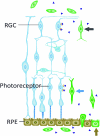Mesenchymal stem cells for retinal diseases
- PMID: 22553693
- PMCID: PMC3340881
- DOI: 10.3980/j.issn.2222-3959.2011.04.19
Mesenchymal stem cells for retinal diseases
Abstract
Retinal diseases are featured with the common result of retinal cell apoptosis that will cause irreversible vision loss. Various attempts have been made for the solution against cell death. However, few approaches turn out to be effective. With the progress in mesenchymal stem cells (MSCs) research, MSCs were considered as a promising source for cell replacement or neuroprotection in retinal disorders. MSCs have the property of self-renewal and are multipotent cells derived from various mesenchymal tissues, which were demonstrated being capable of differentiating into multilineage tissue cells. Some works were also done to differentiate MSCs into retinal cells. MSCs could be induced to express retinal cell markers under certain stimuli. Recent studies also suggest that MSCs should be an ideal source for neuroprotection via the secretion of a variety of neurotrophins. Engineered MSCs were also used as vehicles for continuous delivery of neurotrophins against retinal degeneration with encouraging results. Since there are still barriers on the differentiation of MSCs into functional retinal cells, the use of MSCs for neuroprotection in retinal diseases seems to be a more practicable approach and worthy of further investigations.
Keywords: differentiation; mesenchymal stem cells; neurotrophin; retina.
Figures



Similar articles
-
Overview of retinal differentiation potential of mesenchymal stem cells: A promising approach for retinal cell therapy.Ann Anat. 2017 Mar;210:52-63. doi: 10.1016/j.aanat.2016.11.010. Epub 2016 Dec 13. Ann Anat. 2017. PMID: 27986614 Review.
-
The Identification of Interferon-γ as a Key Supportive Factor for Retinal Differentiation of Murine Mesenchymal Stem Cells.Stem Cells Dev. 2017 Oct 1;26(19):1399-1408. doi: 10.1089/scd.2017.0111. Epub 2017 Aug 22. Stem Cells Dev. 2017. PMID: 28728472
-
Intravitreal administration of multipotent mesenchymal stromal cells triggers a cytoprotective microenvironment in the retina of diabetic mice.Stem Cell Res Ther. 2016 Mar 16;7:42. doi: 10.1186/s13287-016-0299-y. Stem Cell Res Ther. 2016. PMID: 26983784 Free PMC article.
-
A Promising Tool in Retina Regeneration: Current Perspectives and Challenges When Using Mesenchymal Progenitor Stem Cells in Veterinary and Human Ophthalmological Applications.Stem Cell Rev Rep. 2017 Oct;13(5):598-602. doi: 10.1007/s12015-017-9750-4. Stem Cell Rev Rep. 2017. PMID: 28643176 Free PMC article. Review.
-
Effect of β-carotene on the differentiation potential of ciliary epithelium-derived MSCs isolated from mouse eyes on alginate-based scaffolds.Exp Eye Res. 2021 Jan;202:108346. doi: 10.1016/j.exer.2020.108346. Epub 2020 Nov 2. Exp Eye Res. 2021. PMID: 33147471
Cited by
-
Proliferation and differentiation of direct co‑culture of bone marrow mesenchymal stem cells and pigmented cells from the ciliary margin.Mol Med Rep. 2017 Jun;15(6):3529-3534. doi: 10.3892/mmr.2017.6481. Epub 2017 Apr 19. Mol Med Rep. 2017. PMID: 28440470 Free PMC article.
-
Mesenchymal stem cell therapy in retinal and optic nerve diseases: An update of clinical trials.World J Stem Cells. 2016 Nov 26;8(11):376-383. doi: 10.4252/wjsc.v8.i11.376. World J Stem Cells. 2016. PMID: 27928464 Free PMC article. Review.
-
Intravitreal autologous mesenchymal stem cell transplantation: a non-randomized phase I clinical trial in patients with retinitis pigmentosa.Stem Cell Res Ther. 2021 Jan 9;12(1):52. doi: 10.1186/s13287-020-02122-7. Stem Cell Res Ther. 2021. PMID: 33422139 Free PMC article. Clinical Trial.
-
Hypoxia-Preconditioned Placenta-Derived Mesenchymal Stem Cells Rescue Optic Nerve Axons Via Differential Roles of Vascular Endothelial Growth Factor in an Optic Nerve Compression Animal Model.Mol Neurobiol. 2020 Aug;57(8):3362-3375. doi: 10.1007/s12035-020-01965-8. Epub 2020 Jun 10. Mol Neurobiol. 2020. PMID: 32524519
-
Neurosphere-Free Transdifferentiation of Rat Bone Marrow Stromal Stem Cells Into Retinal Cells and Retinal Pigment Epithelium.Basic Clin Neurosci. 2021 Sep-Oct;12(5):617-628. doi: 10.32598/bcn.2021.1055.3. Epub 2021 Sep 1. Basic Clin Neurosci. 2021. PMID: 35173916 Free PMC article.
References
-
- Quevedo HC, Hatzistergos KE, Oskouei BN, Feigenbaum GS, Rodriguez JE, Valdes D, Pattany PM, Zambrano JP, Hu Q, McNiece I, Heldman AW, Hare JM. Allogeneic mesenchymal stem cells restore cardiac function in chronic ischemic cardiomyopathy via trilineage differentiating capacity. Proc Natl Acad Sci USA. 2009;106:14022–14027. - PMC - PubMed
-
- Sasportas LS, Kasmieh R, Wakimoto H, Hingtgen S, van de Water Jeroen AJM, Mohapatra G, Figueiredo JL, Martuza RL, Weissleder R, Shah K. Assessment of therapeutic efficacy and fate of engineered humanmesenchymal stem cells for cancer therapy. Proc Natl Acad Sci USA. 2009;106:4822–4827. - PMC - PubMed
-
- Amado LC, Saliaris AP, Schuleri KH, St John M, Xie JS, Cattaneo S, Durand DJ, Fitton T, Kuang JQ, Stewart G, Lehrke S, Baumgartner WW, Martin BJ, Heldman AW, Hare JM. Cardiac repair with intramyocardial injection of allogeneic mesenchymal stem cells after myocardial infarction. Proc Natl Acad Sci USA. 2005;102:11474–11479. - PMC - PubMed
LinkOut - more resources
Full Text Sources
Other Literature Sources
